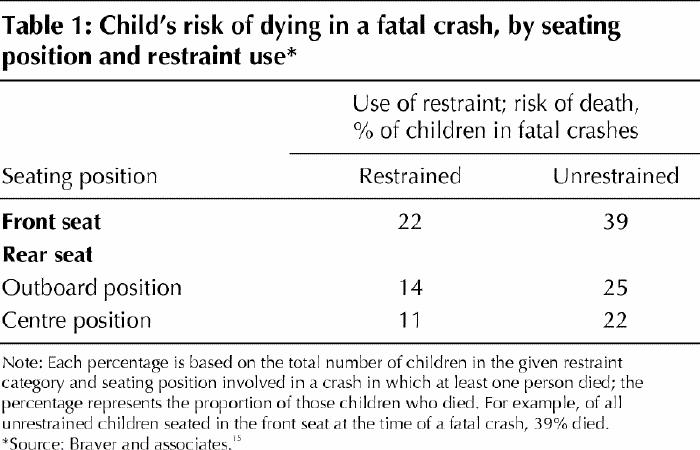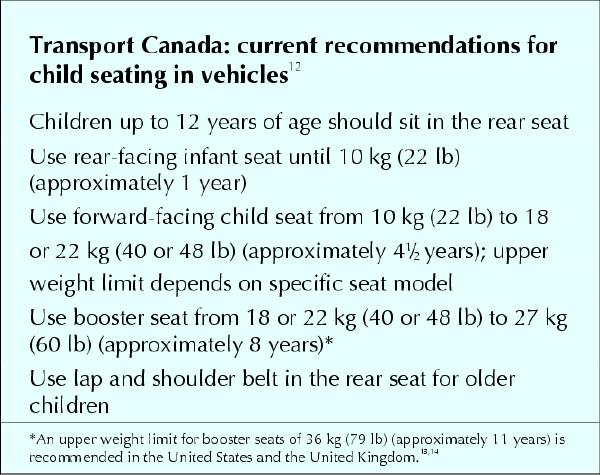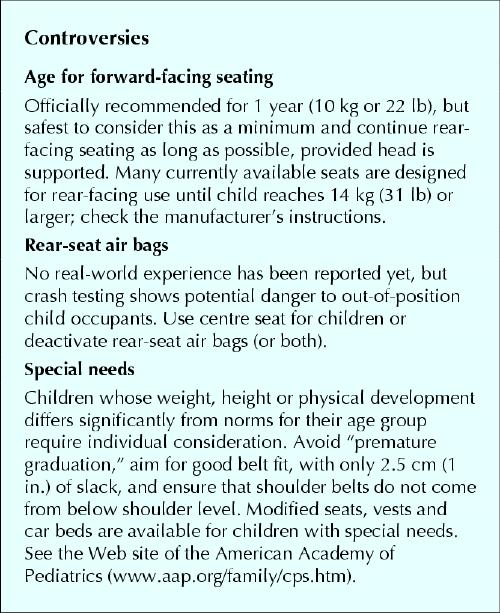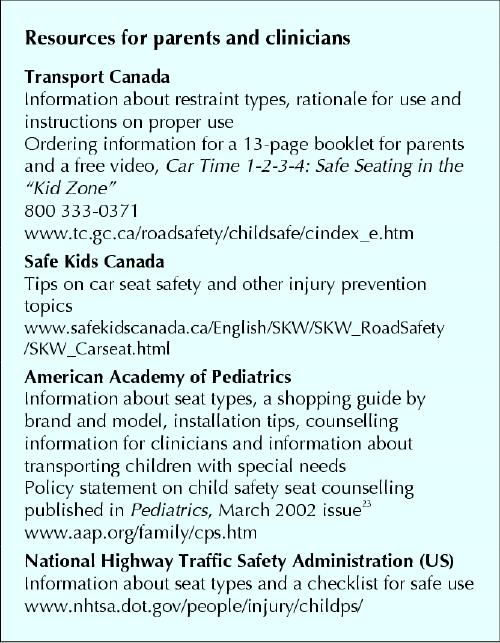Abstract
MORE CANADIAN CHILDREN DIE OF ROAD TRAFFIC INJURIES than of any other cause. Nonuse and misuse of child restraints is common and leads to preventable severe injuries or deaths. This article, intended for clinicians interested in injury prevention counselling, advocacy, research, and treatment of child occupants in car crashes, reviews current knowledge about child safety seats and discusses controversies related to their use. Children should sit in the back seat of a vehicle and should be properly restrained in a current age- and size-appropriate device (rear-facing infant seat, child safety seat, booster seat, or lap and shoulder seat belt) that is properly adjusted. The centre rear seat is safer than side positions, but a lap belt alone should be avoided. The age at which children should start sitting in a forward-facing position is controversial. Children should be seated away from air bags. Resources to aid in patient counselling are described.
More Canadian children die from road traffic injuries than from any other cause.1 Non-use of child restraints is common among those killed or injured.2,3,4 In addition, misuse of child restraints is common5,6,7,8,9 and can lead to severe injury.10 Yet death and disability of children involved in motor vehicle crashes can be prevented. Discussing safe travel with parents may be a clinician's most important child health promotion activity. It is known that clinicians can engender short-term behaviour change by counselling about use of child safety seats,11 even though the optimal means of ensuring protection of children in vehicles over the long term remains unknown.
In addition to counselling, clinicians may be involved in treatment of injuries, advocacy, public education campaigns, legislation and research. This paper reviews current knowledge about and controversies related to child restraint in vehicles and directs readers to resources to aid in counselling.
Current knowledge about restraints
Four types of child restraint are recommended by Transport Canada,12 depending on the child's size. Infants up to 10 kg (22 lb) should be seated in a rear-facing infant carrier. Toddlers from 10 kg to 18 or 22 kg (22 lb to 40 or 48 lb) should be seated in a forward-facing child safety seat, the upper weight limit depending on the seat model. Children from 18 or 22 kg to 27 kg (40 or 48 lb to 60 lb) should be seated in a booster seat. The recommended upper weight limit for booster seats is 36 kg (79 lb) in the United States13 and the United Kingdom.14 Larger children should use a lap or shoulder seat belt in the rear seat.
Seating position and restraint effectiveness
The rear seat of a vehicle is the safest seat. Braver and associates15 estimated that rear seating reduced the risk of death by 36% for children involved in fatal crashes, regardless of whether the child was restrained (Table 1). Berg and colleagues16 demonstrated that children in rear seats were 1.7 times less likely (95% confidence interval [CI] 1.6–2.0) to suffer a fatal or severe injury than front seat occupants. These studies included children up to 12 or 14 years respectively, so they encompass ages when child safety seats and seat belts are recommended.
Table 1

Kahane17 estimated that correctly used child safety seats reduced the risk of fatality by 71% and the risk of serious injury by 67%. Isaksson-Hellman and collaborators18 concluded that large, rear- facing child restraints for children up to 3 years old (a design used in Scandinavian countries) reduced injuries by 96%. Miller and associates19 estimated that each dollar spent on a child seat in the United States saved $2 in medical care, $6 in other tangible costs and the equivalent of $25 in quality of life (based on insurer payouts for pain and suffering).
Rates of restraint use
Rates of restraint use fall as children grow older. In Canada in 1997, the rates were 96% for infants, 91% for children 1 to 4 years old and 85% for those 5 to 15 years old.20 Corresponding rates of restraint use in the United States for 1996 were 85%, 60% and 65%.21 Only 56% of children (under 10 years of age) involved in fatal crashes in the United States in 1994 were restrained.2 The strongest predictor of use of a child restraint in fatal crashes was the driver's use of a restraint.2
Rates of restraint misuse
Parents must select an appropriate device for each child, secure it properly to the car and adjust it properly to fit the child as he or she grows. Thus, it is not surprising that misuse of these important but complex devices is the norm. Misuse rates have ranged from 44% to 81% for child safety seats and 33% to 50% for booster seats in different jurisdictions.5,6,7,8,9
Age for forward-facing seating
The American Academy of Pediatrics has recently advised that children should be seated facing the rear of the vehicle for as long as possible and at least until 1 year of age.22,23 Facing rearward is intrinsically safer, provided the head is supported, and the reasons for seating a child in the opposite position relate to convenience, not safety.24,25 With heavy heads and weak necks, children are vulnerable to catastrophic traction injuries to the cervical cord,26,27,28,29 and children older than 1 year retain this vulnerability.26,28,30,31 In contrast, there are no reports of catastrophic neurologic injury for children in the rear-facing position.24,25 Both Transport Canada12 and the US National Highway Traffic Safety Administration13 currently suggest having children face forward from about 1 year of age or once they reach 10 kg (22 lb). Nonetheless, many currently available child safety seats are designed for rear-facing use until the child reaches 14 kg (31 lb),22 which prolongs the period that children can be kept safer by facing rearward.
Premature graduation
Children are commonly “graduated” to inappropriate restraints too early. In one observational study 21% of toddlers (9 to 18 kg [20 to 40 lb]) and 75% of preschoolers (18 to 27 kg [40 to 60 lb]) were restrained by a seat belt only.7 In another study 28% of 4-year-olds, 36% of 5-year-olds and 70% of 6- to 8-year-olds were restrained by a seat belt only.32 More than 50% of parents owned the appropriate device but believed, incorrectly, that their children were large enough for a seat belt.32 Children 2 to 5 years of age who crashed wearing a seat belt had a relative risk (compared with children in child seats) of significant injury of 3.5 (95% CI 2.4–4.2) and a relative risk of significant head injury of 4.2 (95% CI 2.6–6.7).10
Current knowledge about injuries
Lap belt injuries
Lap belt injuries are a well-described clinical entity. The full triad includes bruising of the abdominal wall, abdominal viscus injury and vertebral fracture.33,34,35,36,37,38,39 Lap belt use in a frontal crash should trigger a careful search for clinically inapparent injury, since diagnostic delays remain common.36,37,38 Children are prone to lap belt injuries because they often slouch with the belt loose and across the abdomen (rather than the hips). A booster seat corrects these problems by lifting the child up and forward, allowing better fit of both the lap and the shoulder belts. Recommendations for booster seat use extend to 27 kg (60 lb) or 8 years in Canada12 and to 36 kg (79 lb) or 11 years in the United States13 and the United Kingdom.14 However, actual use is very low in most countries, and preventable lap belt injuries continue to occur.
Ejections
Children in loose seat belts or loose child safety seat harnesses are at risk of ejection from a vehicle, especially if it rolls over.40,41 Although specific data for children are not available, ejection carries an 8-fold increase in fatality risk for adults,42 and a similar factor might be expected for children. Loosely fitting (i.e., improperly fitted) child safety seat harnesses are endemic.5,6,8,9 Thus, even though rollovers are rare — 1% to 2% of crashes — they account for 29% of child crash fatalities in the United States.41 Optimizing protection of children against ejection injuries requires universal use of restraints and better understanding of how restraints can prevent ejection.
Side impacts
Side impact crashes are dangerous for children and represent a challenge to prevention efforts. Agran and colleagues43 found that significant injuries occurred in 41% of side impact crashes, 15% of frontal impacts and 3% of rear impacts involving restrained school-age children.43 Braver and associates15 reported a child fatality rate of 30% for side impact crashes and 17% for frontal impact crashes. Restraints did not significantly influence the likelihood or severity of injury for children on the struck side in side impact crashes.44 The best advice is to seat the child in the centre position whenever possible and to ensure that age-appropriate restraints are used. Particular care must be taken to tighten straps to limit the lateral mobility of the child's head.
Air bag injuries
Children occupying the front seat have been killed or severely injured by front passenger air bags, even in minor crashes.45,46,47,48,49 The bag inflates quickly from a chemical explosion likened to a collision at 300 km/h.47,50 Children in the zone of inflation can suffer fatal injuries to the head and cervical spine. Several factors contribute to this problem. Children are poorly held by large seat belts (such as those available in the front seat), they move around while the vehicle is moving, and child safety seats (particularly rear- facing seats, which hold the head within the zone of air bag inflation) are often erroneously used in the front seat.50 Current air bag systems have higher thresholds for deployment than those initially marketed, but they are still unsafe for children. Children under 13 years of age must be seated in the rear, away from the air bags.
Side air bags in the rear seat are currently available in only a small number of luxury vehicles. There is little crash experience of their effect on child occupants. Transport Canada found that rear-seat air bags could cause injury — sometimes serious — to out-of-position 3- and 6-year-old child dummies.51 Since most children are out of position for portions of any journey, it is wise to avoid rear-seat air bags in cars where children are the intended passengers. Current US policy is that cars with rear air bags be sold with the bags deactivated, to avoid injury to children.52
New anchorage systems
New systems that simplify the installation of child safety seats are currently available and are required in all new cars sold in Canada as of September 2002. Clips on the child safety seat attach to fixed horizontal bars between the seat cushions. These bars (referred to as isofix or LATCH systems) provide an easier and more secure means of attachment than vehicle seat belts but will be available only in new vehicles. A top tether strap anchor point will also be provided in rear seating positions. Older vehicles without tether anchor points can be retrofitted by dealers. The standards for these systems are similar in North America53 and Europe.54 Real-world crash experience will be needed to confirm the expected benefits of lower rates of misuse and more limited movement of the child safety seat during crashes. Simplification of the belt harness for children, while optimizing crash performance, will be the next challenge in the design of child restraints.
Conclusions
Children should sit in the rear seat of a vehicle. Each child should be restrained in a current age- and size-appropriate device (rear-facing infant seat, child safety seat, booster seat, or lap or shoulder seat belt) that is properly adjusted. They should be seated away from air bags.
Children are routinely weighed and measured during regular health visits to clinicians. The greatest health benefit of this information could be realized if it is used to ensure that children travel safely in cars. An optimal counselling intervention has not yet been defined, but the resources listed in the sidebar provide detailed and practical information for clinicians and families.
Figure.

Figure.

Figure.

Footnotes
Note: A table providing a more detailed literature review is available at eCMAJ at www.cmaj.ca (see Table 2 of this article).
This article has been peer reviewed.
Competing interests: None declared.
Correspondence to: Dr. Andrew W. Howard, The Hospital for Sick Children, 555 University Ave., Room S-107, Toronto ON M5G 1X8; fax 416 813-6414; andrew.howard@sickkids.ca
References
- 1.A league table of child deaths by injury in rich nations. Florence: UNICEF Innocenti Research Centre; 2001.
- 2.Agran PF, Anderson CL, Winn DG. Factors associated with restraint use of children in fatal crashes. Pediatrics 1998;102(3):e39. Available: www.pediatrics.org/cgi/content/full/102/3/e39 (accessed 2002 Sep 2). [DOI] [PubMed]
- 3.Motor-vehicle occupant fatalities and restraint use among children aged 4–8 years — United States, 1994–1998. JAMA 2000;283(17):2233-4. [PubMed]
- 4.From the Centers for Disease Control. Child passenger restraint use and motor vehicle-related fatalities among children — United States, 1982–1990. JAMA 1991;266(14):1913. [PubMed]
- 5.Auger A, Letendre P. Les sièges d'auto pour enfants au Québec: évolution du taux d'utilisation (1990–1997) et promotion. In: Proceedings of the 11th Canadian Multidisciplinary Road Safety Conference; 1999 May 9–12; Halifax [CD-ROM].
- 6.Campbell H, Macdonald S, Richardson P. High levels of incorrect use of car seat belts and child restraints in Fife — an important and under-recognised road safety issue. Inj Prev 1997;3(1):17-22. [DOI] [PMC free article] [PubMed]
- 7.Decina LE, Knoebel KY. Child safety seat misuse patterns in four states. Accid Anal Prev 1997;29(1):125-32. [DOI] [PubMed]
- 8.Eby D, Kostyniuk L. A statewide analysis of child safety seat use and misuse in Michigan. Accid Anal Prev 1999;31:555-66. [DOI] [PubMed]
- 9.Margolis LH, Wagenaar AC, Molnar LJ. Use and misuse of automobile child restraint devices. Am J Dis Child 1992;146(3):361-6. [DOI] [PubMed]
- 10.Winston FK, Durbin DR, Kallan M, Moll E. The danger of premature graduation to seat belts for young children. Pediatrics 2000;105(6):1179-83. [DOI] [PubMed]
- 11.Grossman DC, Garcia CC. Effectiveness of health promotion programs to increase motor vehicle occupant restraint use among young children. Am J Prev Med 1999;16:12-22. [DOI] [PubMed]
- 12.Child safety. In: Road safety [Web site]. Ottawa: Transport Canada, Road Safety Division; updated 2002 Aug 15. Available: www.tc.gc.ca/roadsafety/childsafe/cindex_e.htm (accessed 2002 Aug 30).
- 13.Child passenger safety [Web site]. Washington: US Department of Transport, National Highway Traffic Safety Administration; [no date]. Available: www .nhtsa.dot.gov/people/injury/childps/ (accessed 2002 Sep 2).
- 14.Seat belts and child restraints. London: UK Department of Environment, Transport and the Regions, Road Safety Division; 1999 (reprinted 2000). Available: www.think.dft.gov.uk/childcarseats (accessed 2002 Sep 2).
- 15.Braver ER, Whitfield R, Ferguson SA. Seating positions and children's risk of dying in motor vehicle crashes. Inj Prev 1998;4:181-7. [DOI] [PMC free article] [PubMed]
- 16.Berg M, Cook L, Corneli H, Vernon DD, Dean M. Effect of seating position and restraint use on injuries to children in motor vehicle crashes. Pediatrics 2000; 105(4):831-5. [DOI] [PubMed]
- 17.Kahane CJ. An evaluation of child passenger safety: the effectiveness and benefits of safety seats. Washington: US Department of Transport, National Highway Traffic Safety Administration; 1986. Report no.: DOT HS 806 890.
- 18.Isaksson-Hellman I, Jakobsson L, Gustafsson C, Norin H. Trends and effects of child restraint systems based on Volvo's Swedish accident database. In: Proceedings of the 2nd Child Occupant Protection Symposium. Warrendale (PA): Society of Automotive Engineers; 1997. Report no.: SAE 973299. p. 43-54.
- 19.Miller TR, Demes JC, Bovbjerg RR. Child seats: How large are the benefits and who should pay? Warrendale (PA): Society of Automotive Engineers; 1993. Report no.: SP-986.
- 20.Child restraint use in Canada: 1997 survey data. Ottawa: Transport Canada; [no date]. Available: www.tc.gc.ca/roadsafety/stats/cl9804/eng/crutb1_e.htm (accessed 2002 Aug 22).
- 21.National occupant protection use survey — 1996. Controlled intersection study. Washington: US Department of Transport, National Highway Traffic Safety Administration; 1997. Available: www-nrd.nhtsa.dot.gov/pdf/nrd-30 /NCSA/RNotes/1997/Nopusci2.pdf (accessed 2002 Aug 22).
- 22.Car safety seats: a guide for families. In: American Academy of Pediatrics [Web site]. Elk Grove Village (IL): The Acadamy; 2002. Available: www .aap.org /family/carseatguide.htm (accessed 2002 Sep 2).
- 23.Selecting and using the most appropriate car safety seats for growing children: guidelines for counseling parents. Pediatrics 2002;109(3):550-3. [DOI] [PubMed]
- 24.Weber K. Crash protection for child passengers: a review of best practice. UMTRI Res Rev [University of Michigan Transportation Research Institute] 2000; 31(3):1-27.
- 25.Weber K. Rear-facing restraint for small child passengers: a medical alert. UMTRI Res Rev [University of Michigan Transportation Research Institute] 1995;25(5):12-7.
- 26.Neville BG. Hyperflexion cervical cord injury in a children's car seat [letter]. Lancet 1981;2:103-4. [DOI] [PubMed]
- 27.Huelke DF, Mackay GM, Morris A, Bradford M. A review of cervical fractures and fracture-dislocations without head impacts sustained by restrained occupants. Accid Anal Prev 1993;25(6):731-43. [DOI] [PubMed]
- 28.Hoy GA, Cole WG. The paediatric cervical seat belt syndrome. Injury 1993; 24 (5):297-9. [DOI] [PubMed]
- 29.Fuchs S, Barthel MJ, Flannery AM, Christoffel KK. Cervical spine fractures sustained by young children in forward-facing car seats. Pediatrics 1989;84 (2): 348-54. [PubMed]
- 30.Vedantam R, Crawford AH. Multiple noncontiguous injuries of the spine in a child: atlantooccipital dislocation and seat-belt injury of the lumbar spine. Acta Orthop Belg 1997;63(1):23-7. [PubMed]
- 31.Williams N, Rose GK, Goodman AM. Lap-style seat belt associated with high cervical cord injury in a child. Injury 1993;24(3):209-10. [DOI] [PubMed]
- 32.Ramsey A, Simpson E, Rivara FP. Booster seat use and reasons for nonuse. Pediatrics 2000;106(2);e20. Available: www.pediatrics.org/cgi/content/full/106/2/e20 (accessed 2002 Aug 22). [DOI] [PubMed]
- 33.Anderson PA, Rivara FP, Maier RV, Drake C. The epidemiology of seatbelt-associated injuries. J Trauma 1991;31(1):60-7. [DOI] [PubMed]
- 34.Garrett JW, Braunstein PW. The seat belt syndrome. J Trauma 1962;2:220-38. [DOI] [PubMed]
- 35.Glassman SD, Johnson JR, Holt RT. Seatbelt injuries in children. J Trauma 1992; 33(6):882-6. [DOI] [PubMed]
- 36.LeGay DA, Petrie DP, Alexander DI. Flexion-distraction injuries of the lumbar spine and associated abdominal trauma. J Trauma 1990;30(4):436-44. [PubMed]
- 37.Rumball K, Jarvis J. Seat-belt injuries of the spine in young children. J Bone Joint Surg Br 1992;74(4):571-4. [DOI] [PubMed]
- 38.Reid AB, Letts RM, Black GB. Pediatric chance fractures: association with intra-abdominal injuries and seatbelt use. J Trauma 1990;30(4):384-91. [PubMed]
- 39.Sturm PF, Glass RB, Sivit CJ, Eichelberger MR. Lumbar compression fractures secondary to lap-belt use in children. J Pediatr Orthop 1995;15(4):521-3. [DOI] [PubMed]
- 40.Scheidler M, Shultz B, Schall L, Ford H. Risk factors and predictors of mortality in children after ejection from motor vehicle crashes. J Trauma 2000; 49 (5): 864-8. [DOI] [PubMed]
- 41.Howard AW, Mckeag AM, Rothman L, Comeau JL, Monk B, German A. Ejections of young children in motor vehicle crashes. J Trauma. In press. [DOI] [PubMed]
- 42.Esterlitz J. Relative risk of death from ejection by crash type and crash mode. Accid Anal Prev 1989;21(5):459-68. [DOI] [PubMed]
- 43.Agran P, Winn D, Dunkle D. Injuries among 4- to 9-year-old restrained motor vehicle occupants by seat location and crash impact site. Am J Dis Child 1989; 143 (11):1317-21. [DOI] [PubMed]
- 44.Arbogast KB, Moll EK, Morris SD, Anderko RL, Durbin DR, Winston FK. Factors influencing pediatric injury in side impact collisions. J Trauma 2001; 51: 469-77. [DOI] [PubMed]
- 45.Bourke GJ. Airbags and fatal injuries to children [letter]. Lancet 1996; 347 (9001):560. [DOI] [PubMed]
- 46.German A, Dalmotas D, Comeau JL, Monk B, Contant P, Gou M, et al. In-depth investigation and reconstruction of an air bag induced child fatality. In: Proceedings of 16th Enhanced Safety of Vehicles international technical conference; 1998; Windsor, Ont. p. 1126-34.
- 47.Hollands CM, Winston FK, Stafford PW, Shochat SJ. Severe head injury caused by airbag deployment. J Trauma 1996;41(5):920-2. [DOI] [PubMed]
- 48.Mehlman CT, Scott KA, Koch BL, Garcia VF. Orthopaedic injuries in children secondary to airbag deployment. J Bone Joint Surg Am 2000;82(6):895-8. [DOI] [PubMed]
- 49.Willis BK, Smith JL, Falkner LD, Vernon DD, Walker ML. Fatal air bag mediated craniocervical trauma in a child. Pediatr Neurosurg 1996;24(6):323-7. [DOI] [PubMed]
- 50.Update: fatal air bag-related injuries to children — United States, 1993–1996. MMWR Morb Mortal Wkly Rep 1996;45(49):1073-6. [PubMed]
- 51.Tylko S, Dalmotas D. Dangerous sides. Recovery Mag [Insurance Corporation of British Columbia] 2001;12(51).
- 52.NHTSA issues consumer advisory on side air bags and child safety [press release]. Washington: US Department of Transport, National Highway Traffic Safety Administration; 1999 Oct 14. Available: www.nhtsa.dot.gov/nhtsa/announce/press/1999/ca101499.html (accessed 2002 Aug 22).
- 53.Lower anchors and tethers for children (LATCH). Washington: US Department of Transport, National Highway Traffic Safety Administration; [no date]. Available: www.nhtsa.dot.gov/people/injury/childps/csr2001/csrhtml/LATCH.html (accessed 2002 Aug 22).
- 54.ISO at the heart of automobile safety. ISO Bull [International Organization for Standardization] 2000;April:13-6.


